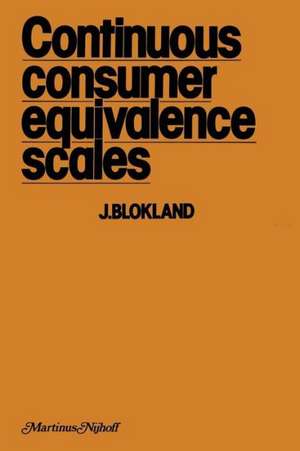Continuous Consumer Equivalence Scales: Item-specific effects of age and sex of household members in the budget allocation model
Autor J. Bloklanden Limba Engleză Paperback – 31 iul 1976
Preț: 381.59 lei
Nou
Puncte Express: 572
Preț estimativ în valută:
73.02€ • 76.51$ • 60.36£
73.02€ • 76.51$ • 60.36£
Carte tipărită la comandă
Livrare economică 12-26 aprilie
Preluare comenzi: 021 569.72.76
Specificații
ISBN-13: 9789024718474
ISBN-10: 9024718473
Pagini: 192
Ilustrații: XI, 176 p.
Dimensiuni: 152 x 229 x 10 mm
Greutate: 0.26 kg
Ediția:Softcover reprint of the original 1st ed. 1976
Editura: Springer Us
Colecția Springer
Locul publicării:New York, NY, United States
ISBN-10: 9024718473
Pagini: 192
Ilustrații: XI, 176 p.
Dimensiuni: 152 x 229 x 10 mm
Greutate: 0.26 kg
Ediția:Softcover reprint of the original 1st ed. 1976
Editura: Springer Us
Colecția Springer
Locul publicării:New York, NY, United States
Public țintă
ResearchCuprins
1. Scope and method of the study.- 2. Earlier contributions to the estimation of family-size effects on expenditure.- 2.1. Possible contributions of survey data.- 2.2. Normative approach.- 2.3. Empirical approach.- 2.4. Concluding remarks.- 3. The expenditure allocation model.- 3.1. Model without family size effects.- 3.2. Model incorporating family size effects.- Appendix 3.A. Derivation of homogeneous demand functions from the Slutsky conditions imposed on the expenditure allocation model.- Appendix 3.B. Conditions for a budget constrained utility maximum imposed on the expenditure allocation model without family size effects.- Appendix 3.C. Conditions for a contrained utility maximum imposed on the expenditure allocation model incorporating family size effects.- Appendix 3.D. Derivation of parameter equations for the standard consumer functions.- 4. Estimation of family size effects in the expenditure allocation model.- 4.1. Model with direct identification of the parameters.- 4.2. Model with indirect identification of the parameters.- 5. Results of the indirect estimation procedure.- 5.1. Survey.- 5.2. Allocation of the total budgets to three large categories.- 5.3. Allocation of the food budget to seven categories.- 5.4. Comparison between the present results and those of Prais and Houthakker.- 5.5. Comparison between the present results and the results obtained with some ‘naive’ models.- 6. Summary.- Annexes.- Selected Bibliography.










